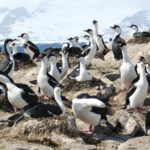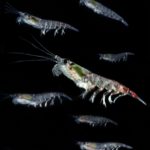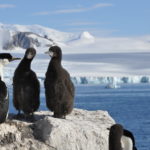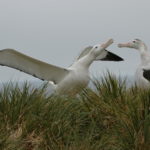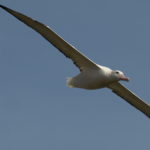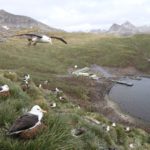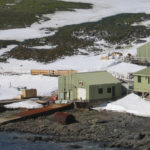The British Antarctic Survey carries out Long Term Science that measures changes in Antarctic ecosystems and seeks to understand the underlying drivers and processes. Marine predators are sensitive to changes in the ecosystem, some of which are natural (such as climate variability), whereas others are caused by humans (e.g. fishing). Monitoring breeding populations of seabirds and seals is therefore an important part of the BAS LTS programme, providing scientists and conservationists with indicators of wider changes in the Scotia Sea and elsewhere in the south-west Atlantic. These indicators include estimates of population size and trends, breeding frequency, reproductive success, and the composition of predator diets.
Impacts of climate
BAS data are essential to modelling studies that relate population and breeding performance of seabirds and seals to environmental variability and change. Recent analyses show that modes of climate variability, for example,the Southern Annular Mode and the El Niño Southern Oscillation, affect upper trophic level predators (including seals and penguins).
Science into policy
The Antarctic is unique in that scientists and policy makers from many nations have adopted an ecosystem approach for managing fisheries. One of the objectives of the Ecosystems programme is to help inform the regional conservation and management authority for Southern Ocean fisheries, which is the Convention for the Conservation of Antarctic Marine Living Resources (CCAMLR). BAS data on seabirds contribute to the understanding of threats to these charismatic animals (penguins, albatrosses). In particular, the tracking and population data are used by the Agreement on the Conservation of Albatrosses and Petrels (ACAP) and NGOs, including the BirdLife International global seabird programme to understand the reasons why many of these species are declining. This information is used to develop strategies to minimise or eliminate the major threats, including campaigning for the wider use of mitigation to reduce the high rates of seabird incidental mortality in many Southern Ocean fisheries.
Long Term Science at Bird Island
Situated only 0.5km from the northwest tip of mainland South Georgia, Bird Island is small (4km x 0.5km), with a natural vegetation dominated by tussac grass from rocky coastal beaches to several hundred metres in elevation. Despite its small size, Bird Island holds an incredible number and diversity of land-based marine predators. Confirmed breeding species include three penguin, four albatross, 12 petrels and two seals, a skua, gull, tern, shag, sheathbill, an endemic duck and songbird (pipit). Nonbreeding species that regularly visit include leopard seal and king penguin. BAS scientists have carried out targeted research projects on almost all of these species at some point over the last 2-3 decades.
Long Term Science at Signy Island
The South Orkney Islands are an isolated archipelago on the south Scotia Ridge situated 500 km north-east of the Antarctic Peninsula; Signy Island is in the southwest of the South Orkney archipelago.
The Signy coastline is dominated by sea cliffs, rocks and boulders, these provide nesting habitats for thousands of seabirds including cape petrels, snow petrels and blue-eyed shags. There are also an estimated 18,000 pairs of Adélie penguins, 20,000 pairs of chinstrap penguins and 1,300 pairs of gentoo penguin that breed on the island. In the interior of the island, most of the snow and ice-free areas consist of boulder fields, scree slopes, moraines and lakes. This is a harsh, fellfield environment devoid of higher vegetation but rich in lichens and inhabited by breeding Antarctic prions, Wilson’s storm petrels, subAntarctic skuas and Antarctic terns. Along the west coast of Signy there are luxuriant moss banks, and melt water streams form pools among the rocky outcrops; here over 1000 breeding pairs of southern giant petrel form loosely scattered colonies. During late summer the beaches and adjacent low-lying areas are occupied by up to 20,000 non-breeding Antarctic fur seals. Other visiting seals include Weddell, leopard and crabeater seals, and up to 600 southern elephant seals are in residence for much of the year and breed in small numbers.
Biologists monitor the breeding populations of Adélie, chinstrap and gentoo penguins, southern giant petrels, blue eyed shags, Antarctic fur seals and southern elephant seals.
How do the lifestyles and breeding strategies of higher predators determine their responses to environmental change?
What are the movement patterns and habitat preferences of higher predators, and how do these affect their use of marine resources (prey)?
What are the threats to higher predators from human activities (particularly fisheries)?
14 December, 2021
Data collected from a long-term study by British Antarctic Survey (BAS) scientists shows declining populations of an already relatively rare Antarctic seabird, the South Georgia shag. Published in the journal …
21 January, 2019
The population of Antarctic krill, the favourite food of many whales, penguins, fish and seals, shifted southward during a recent period of warming in their key habitat, new research shows. …
5 December, 2018
Results of a new study on Antarctic seabirds shows a larger percentage of their populations inhabit important nesting sites around Ryder Bay, close to British Antarctic Survey’s Rothera Station than …
20 November, 2017
The populations of wandering, black-browed and grey-headed albatrosses have halved over the last 35 years on sub-antarctic Bird Island according to a new study published today (20 November) in the …
23 October, 2017
Blue Planet II – the nature documentary that explores the deepest and darkest realms of the world’s oceans – is back on the BBC some 16 years after it was …
Bird Island Research Station is an important centre for research into bird and seal biology. Lying off the north-west tip of South Georgia, Bird Island is one of the richest …
Signy Research Station is one of Britain’s smallest stations, and is only occupied in summer. The island’s abundant wildlife and greenery make it an ideal outdoor laboratory. Research at Signy …
